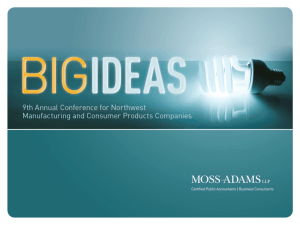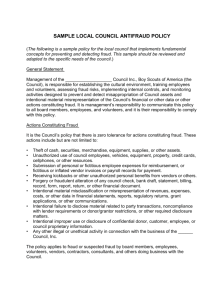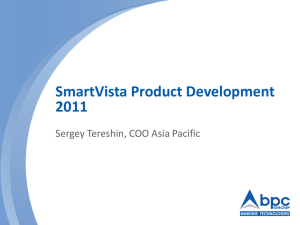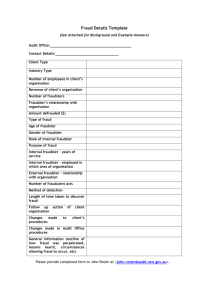fraud: how it happens and how to prevent it
advertisement
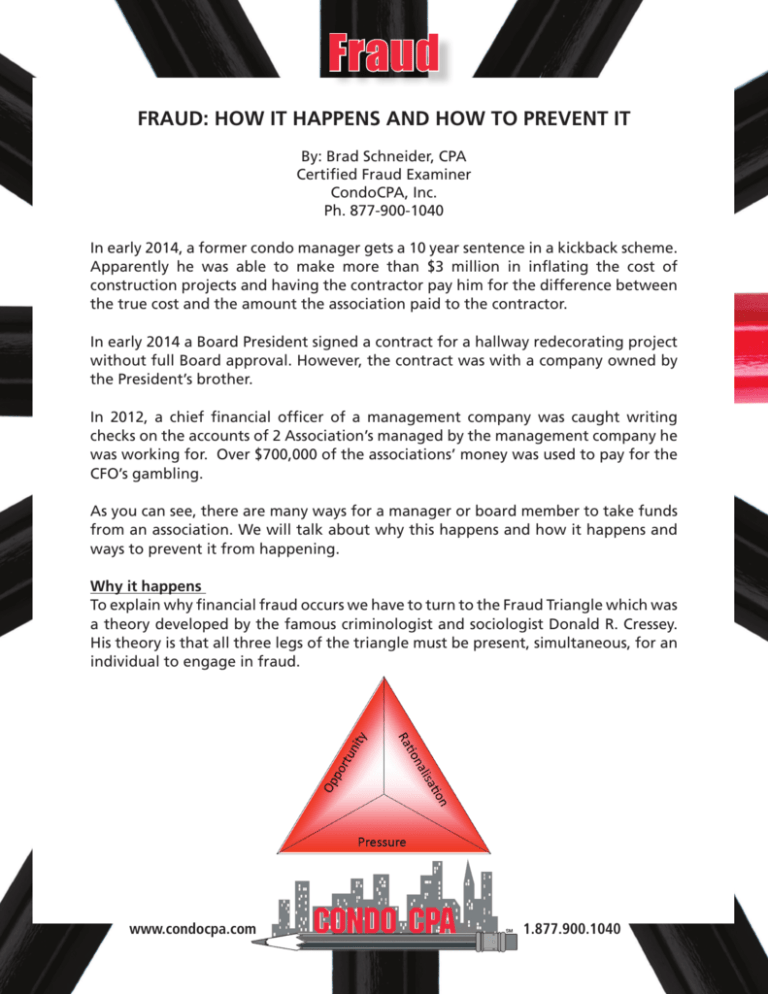
Fraud FRAUD: HOW IT HAPPENS AND HOW TO PREVENT IT By: Brad Schneider, CPA Certified Fraud Examiner CondoCPA, Inc. Ph. 877-900-1040 In early 2014, a former condo manager gets a 10 year sentence in a kickback scheme. Apparently he was able to make more than $3 million in inflating the cost of construction projects and having the contractor pay him for the difference between the true cost and the amount the association paid to the contractor. In early 2014 a Board President signed a contract for a hallway redecorating project without full Board approval. However, the contract was with a company owned by the President’s brother. In 2012, a chief financial officer of a management company was caught writing checks on the accounts of 2 Association’s managed by the management company he was working for. Over $700,000 of the associations’ money was used to pay for the CFO’s gambling. As you can see, there are many ways for a manager or board member to take funds from an association. We will talk about why this happens and how it happens and ways to prevent it from happening. Why it happens To explain why financial fraud occurs we have to turn to the Fraud Triangle which was a theory developed by the famous criminologist and sociologist Donald R. Cressey. His theory is that all three legs of the triangle must be present, simultaneous, for an individual to engage in fraud. www.condocpa.com 1.877.900.1040 The fraud begins with Pressure…usually financial pressures. For example, there is financial pressure when the spouse of the fraudster loses his or her job. The economic pressures brought on by the recession can have a big effect. Some other reasons are the inability for the fraudster to pay their bills or a drug or gambling addiction. (It seems like more and more are happening because of gambling addictions.) The desire for status symbols such as a bigger home or a nicer car. (Keeping up with the Jones’.) It can also be brought on by the need to meet specific professional goals. Opportunity – This is the method in which the crime can be committed. The key elements are Too much Power and keeping the crime a secret. Some ways a person can commit the crime is when there are no segregation of duties. Self-managed associations beware. When the Treasurer or on-site manager is authorizing the invoice, signing the check and producing the financial reports with little or no oversight, look out. Keeping the crime a secret is a key element in the opportunity phase. If the other Board members are actively overseeing the treasurer or manager in these situations, the fraud could be avoided. Having a management company is no guarantee that all fraud will be avoided but most management companies with an accounting department will have developed a much stronger internal control system to help avoid a financial fraud. If the Association is selfmanaged, they should strongly consider outsourcing their financial accounting to a reputable company, whether it is a management company or an accounting firm. The Final leg of the fraud triangle is Rationalization. If the fraudster has financial pressure and opportunity, the rationalization will help them move to commit the fraud. Rationalization is the way the person justifies the act. Some common rationalizations are: 1. “I was only borrowing the money.” 2. “I was entitled to the money.” 3. “I had to steal to provide for my family.” 4. “I was underpaid; my employer deserved it.” 5. “My company does bad things and I got them back for it.” How it happens We have discussed why it happens and partly how it happens. Some of the ways of how frauds occur for community associations are classified in 4 basic categories: 1. Taking income that is meant for the Association. Examples are assessments, user fees, unauthorized waiver of fees or assessments, ancillary income such as antenna income, cable income, vending income, interest income, parking income. 2. Unauthorized or inflated purchase of materials or services from Association funds. Examples are purchasing items for personal use or gain with Association funds. Other examples are kickbacks on contracts signed on behalf of the association. Usage of company credit cards for personal purchases, are included under this category too. Increasing time reported for payroll or ghost employees. 3. Taking of Association equipment or inventory for personal use. Included in this category is when a maintenance person installs items in a unit for personal gain while paying for the parts with Association funds. 4. Use of Association assets for personal gain. Included in this category is using Association investments as collateral on a personal loan or placing Association accounts into a person’s name to gain investment income from the association’s investment. How it is hidden Without the ability to hide the transaction, the economic benefit received by the fraudster would be short lived. There are so many ways to hide the transaction and will vary depending on the transaction being hidden. Below are various ways and are categorized by the method that was used to perpetrate the fraud. Income: Check kiting and adjusting unit owners accounts with other unit owner checks, adjustments to income accounts offsetting the fund balance or shown as a deposit in transit. Income that is taken before it is recorded on the books, as income, can be difficult to trace. If there is no budget for an item such as antenna income, or the budget is very low, then the extra income can be siphoned off with no one noticing. Expense: When the internal controls are not proper, such as when the invoice authorization and the check signing is performed by the same person, the transaction can be easily hidden by changing the paid invoice combined with modifying the accounting records. If proper contract bidding is not done then kickbacks are very difficult to uncover. Using and taking of Association equipment or inventory for personal gain: In order for this to be hidden, controls over equipment and supplies will need to be circumvented or non-exist. Ways to Avoid Fraud Good internal controls go a long way in making it more difficult to be successful in defrauding the Association. The list is very lengthy but I will review some of the important ones: 1. According to the Association of Certified Fraud Examiners, the best way to avoid fraud is by Oversight. Oversight is done at various levels. It can be performed by having an outside auditor audit the books. It can also be by having the manager review the records of the maintenance and other staff members. Oversight is also performed when a supervisor approves or oversees purchases by the managers or by reviewing the financial statements in detail each month. It can also be by having Board members more involved in looking over invoices and understanding financial statements. The more oversight performed by looking over the records and checking the work of others, the more difficult it will be for the fraudster to be successful in hiding a fraudulent transaction. If there is a good chance the transaction will be uncovered by someone, most people will be very hesitant to commit a fraudulent act. Below are some additional positive internal control steps that can help safeguard the Associations assets. ! When bidding out a contract, require at least 3 proposals. Bidding out smaller contracts, often can lead to issues with continuity. Bidding out all contracts every year can be a huge waste of time. Large contracts should always be bid out and the bid specifications should be reviewed so that all proposals are on the same basis. The Board should have some involvement in the bidding process. ! Time cards of employees should at least be reviewed by the on-site manager. (Oversight) ! Avoid having cash taken in by the management office or garage. ! Use Lockbox services whenever possible. (A lockbox is a Post Office box used by a bank so that the owner’s assessments go directly to the bank.) ! Be wary of employees that never go on vacation. ! For larger buildings, have a perpetual inventory system used where usage is traced to work orders. Then usage of more expensive supplies is accounted for. Also, use an equipment inventory. You would be surprised how many items disappear when there is no tracking system used. ! Do background checks for new employees, looking at criminal and credit history. The companies now charge very reasonable fees for these services. ! When reviewing bank reconciliations, look for items that do not clear. Items that tend to be left on the bank reconciliation for many months can turn out to be improperly recorded or a possible suspicious item. ! ! ! Do not sign checks unless all of the evidence of the purchase is attached…for instance, if you have a credit card bill and a large item does not have a receipt wait for the receipt before signing…duplicate receipts are usually available. Many adjustments to receivables are not normal. If there are many adjustments downward to unit owner’s accounts investigate. Items that are put to fund balance should be investigated. Sometimes they are valid but it is a good place to hide fraudulent activity. Remember a good fraud prevention program is worth it’s weight in gold…literally!





